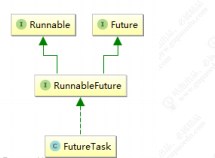FutureTask
FutureTask 的类关系图如下,它实现 RunnableFuture 接口,那么这个 RunnableFuture 接口
的作用是什么呢。
在讲解 FutureTask 之前,先看看 Callable, Future, FutureTask 它们之间的关系图,如下:

public interface RunnableFuture<V> extends Runnable, Future<V> {
/**
* Sets this Future to the result of its computation
* unless it has been cancelled.
*/
void run();
}
RunnableFuture 是一个接口,它继承了 Runnable 和 Future 这两个接口,Runnable 太熟悉
了,那么 Future 是什么呢?
Future 表示一个任务的生命周期,并提供了相应的方法来判断是否已经完成或取消,以及获
取任务的结果和取消任务等。
public interface Future<V> {
boolean cancel(boolean mayInterruptIfRunning);
// 当前的 Future 是否被取消,返回 true 表示已取消
boolean isCancelled();
// 当前 Future 是否已结束。包括运行完成、抛出异常以及取消,都表示当前 Future 已结束
boolean isDone();
// 获取 Future 的结果值。如果当前 Future 还没有结束,那么当前线程就等待,
// 直到 Future 运行结束,那么会唤醒等待结果值的线程的。
V get() throws InterruptedException, ExecutionException;// 获取 Future 的结果值。与 get()相比较多了允许设置超时时间
V get(long timeout, TimeUnit unit)
throws InterruptedException, ExecutionException, TimeoutException;
}
分析到这里我们其实有一些初步的头绪了,FutureTask 是 Runnable 和 Future 的结合,如果
我们把 Runnable 比作是生产者,Future 比作是消费者,那么 FutureTask 是被这两者共享的,
生产者运行 run 方法计算结果,消费者通过 get 方法获取结果。
作为生产者消费者模式,有一个很重要的机制,就是如果生产者数据还没准备的时候,消费
者会被阻塞。当生产者数据准备好了以后会唤醒消费者继续执行。
这个有点像我们上次可分析的阻塞队列,那么在 FutureTask 里面是基于什么方式实现的呢?
state 的含义
表示 FutureTask 当前的状态,分为七种状态
private static final int NEW = 0; // NEW 新建状态,表示这个 FutureTask
还没有开始运行
// COMPLETING 完成状态, 表示 FutureTask 任务已经计算完毕了
// 但是还有一些后续操作,例如唤醒等待线程操作,还没有完成。
private static final int COMPLETING = 1;
// FutureTask 任务完结,正常完成,没有发生异常
private static final int NORMAL = 2;
// FutureTask 任务完结,因为发生异常。
private static final int EXCEPTIONAL = 3;
// FutureTask 任务完结,因为取消任务
private static final int CANCELLED = 4;
// FutureTask 任务完结,也是取消任务,不过发起了中断运行任务线程的中断请求
private static final int INTERRUPTING = 5;
// FutureTask 任务完结,也是取消任务,已经完成了中断运行任务线程的中断请求
private static final int INTERRUPTED = 6;
run 方法
public void run() {
// 如果状态 state 不是 NEW,或者设置 runner 值失败// 表示有别的线程在此之前调用 run 方法,并成功设置了 runner 值
// 保证了只有一个线程可以运行 try 代码块中的代码。
if (state != NEW ||
!UNSAFE.compareAndSwapObject(this, runnerOffset,
null, Thread.currentThread()))
return;
try {
Callable<V> c = callable;
if (c != null && state == NEW) {/ 只有 c 不为 null 且状态 state 为 NEW 的情
况
V result;
boolean ran;
try {
result = c.call(); //调用 callable 的 call 方法,并获得返回结果
ran = true;//运行成功
} catch (Throwable ex) {
result = null;
ran = false;
setException(ex); //设置异常结果,
}
if (ran)
set(result);//设置结果
}
} finally {
// runner must be non-null until state is settled to
// prevent concurrent calls to run()
runner = null;
// state must be re-read after nulling runner to prevent
// leaked interrupts
int s = state;
if (s >= INTERRUPTING)
handlePossibleCancellationInterrupt(s);
}}
其实 run 方法作用非常简单,就是调用 callable 的 call 方法返回结果值 result,根据是否发生
异常,调用 set(result)或 setException(ex)方法表示 FutureTask 任务完结。
不过因为 FutureTask 任务都是在多线程环境中使用,所以要注意并发冲突问题。注意在 run
方法中,我们没有使用 synchronized 代码块或者 Lock 来解决并发问题,而是使用了 CAS 这
个乐观锁来实现并发安全,保证只有一个线程能运行 FutureTask 任务
get 方法
get 方法就是阻塞获取线程执行结果,这里主要做了两个事情
1. 判断当前的状态,如果状态小于等于 COMPLETING,表示 FutureTask 任务还没有完结,
所以调用 awaitDone 方法,让当前线程等待。
2. report 返回结果值或者抛出异常
public V get() throws InterruptedException, ExecutionException {
int s = state;
if (s <= COMPLETING)
s = awaitDone(false, 0L);
return report(s);
}
awaitDone
如果当前的结果还没有被执行完,把当前线程线程和插入到等待队列
private int awaitDone(boolean timed, long nanos)
throws InterruptedException {
final long deadline = timed ? System.nanoTime() +
nanos : 0L;
WaitNode q = null;
boolean queued = false; // 节点是否已添加
for (;;) {
// 如果当前线程中断标志位是 true,
// 那么从列表中移除节点 q,并抛出 InterruptedException 异
常
if (Thread.interrupted()) {
removeWaiter(q);
throw new InterruptedException();}
int s = state;
if (s > COMPLETING) { // 当状态大于 COMPLETING 时,表
示 FutureTask 任务已结束。
if (q != null)
q.thread = null; // 将节点 q 线程设置为 null,
因为线程没有阻塞等待
return s;
}// 表示还有一些后序操作没有完成,那么当前线程让出执行权
else if (s == COMPLETING) // cannot time out yet
Thread.yield();
//表示状态是 NEW,那么就需要将当前线程阻塞等待。
// 就是将它插入等待线程链表中,
else if (q == null)
q = new WaitNode();
else if (!queued)
// 使用 CAS 函数将新节点添加到链表中,如果添加失败,那么
queued 为 false,
// 下次循环时,会继续添加,知道成功。
queued = UNSAFE.compareAndSwapObject(this,
waitersOffset,
q.next =
waiters, q);
else if (timed) {// timed 为 true 表示需要设置超时
nanos = deadline - System.nanoTime();
if (nanos <= 0L) {
removeWaiter(q);
return state;
}
LockSupport.parkNanos(this, nanos); // 让当前线
程等待 nanos 时间
}else
LockSupport.park(this);
}
}
被阻塞的线程,会等到 run 方法执行结束之后被唤醒
report
report 方法就是根据传入的状态值 s,来决定是抛出异常,还是返回结果值。这个两种情况都
表示 FutureTask 完结了
private V report(int s) throws ExecutionException {
Object x = outcome;//表示 call 的返回值
if (s == NORMAL) // 表示正常完结状态,所以返回结果值
return (V)x;
// 大于或等于 CANCELLED,都表示手动取消 FutureTask 任务,
// 所以抛出 CancellationException 异常
if (s >= CANCELLED)
throw new CancellationException();
// 否则就是运行过程中,发生了异常,这里就抛出这个异常
throw new ExecutionException((Throwable)x);
}
线程池对于 Future/Callable 的执行
我们现在再来看线程池里面的 submit 方法,就会很清楚了。
public class CallableDemo implements Callable<String> {
@Override
public String call() throws Exception {
//Thread.sleep(3000);//阻塞案例演示
return "hello world";
}
public static void main(String[] args) throws ExecutionException,
InterruptedException {
ExecutorService es=Executors.newFixedThreadPool(1);CallableDemo callableDemo=new CallableDemo();
Future future=es.submit(callableDemo);
System.out.println(future.get());
}
}
来源沽泡课件
























 4258
4258











 被折叠的 条评论
为什么被折叠?
被折叠的 条评论
为什么被折叠?








